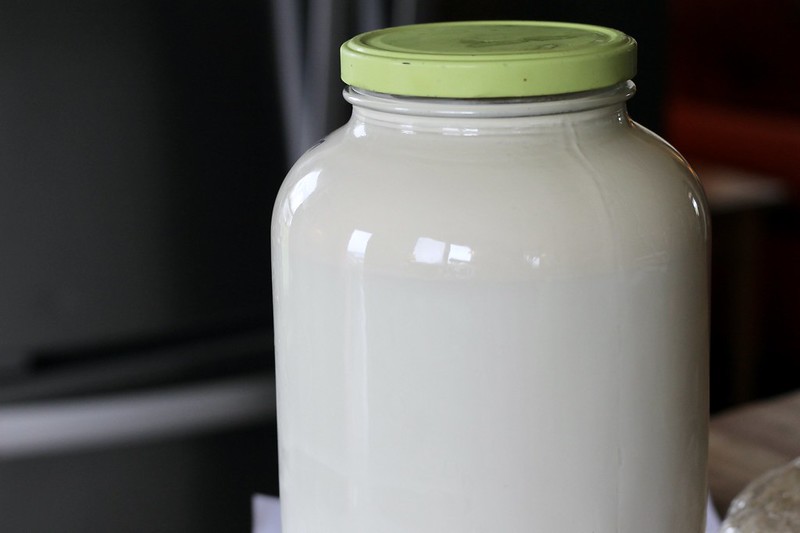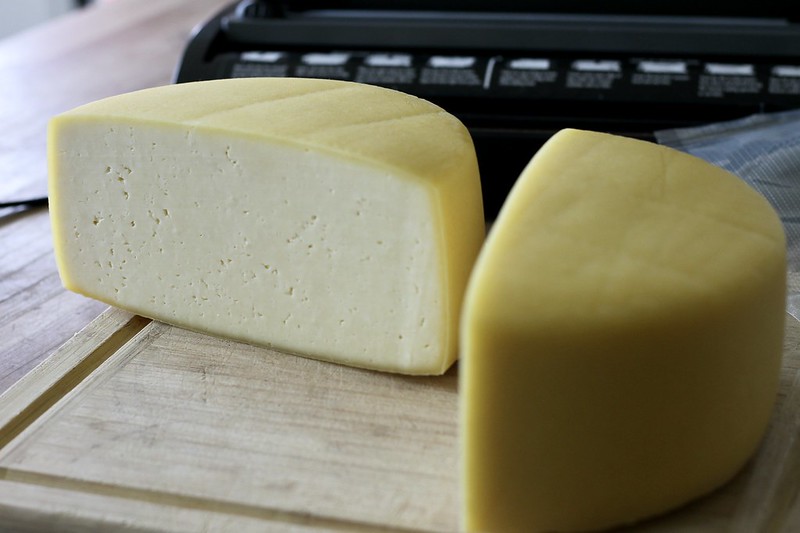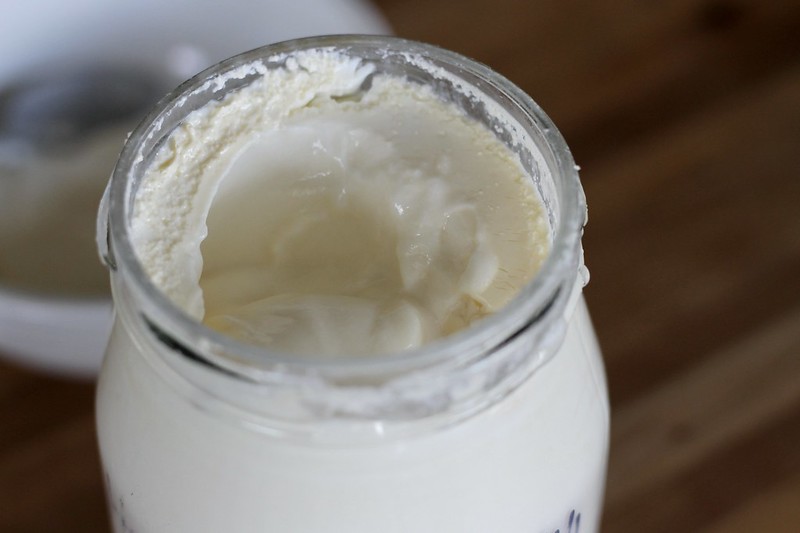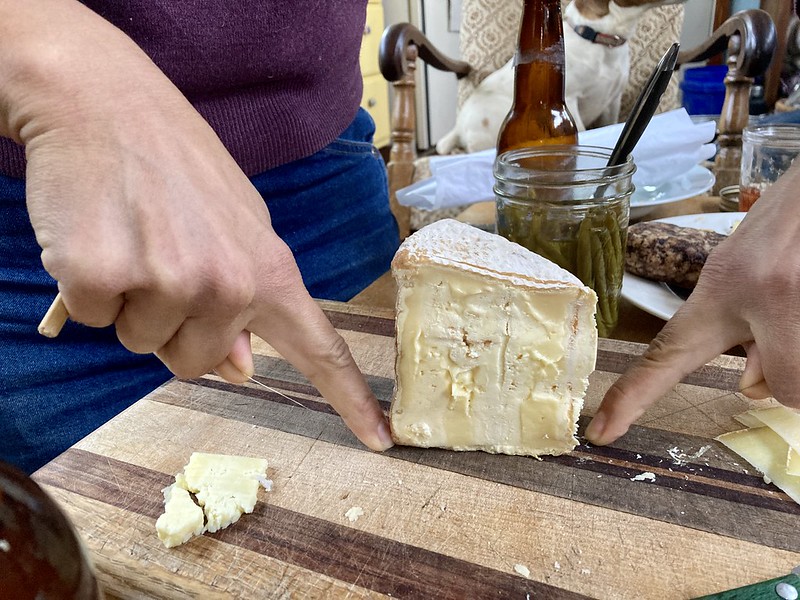How long can you milk a cow?

Dairy farmers usually dry off cows at ten months to give them a short holiday before they have another calf, but since we’re not rebreeding Daisy, how long can we milk her? A year and a half? Three years? It’s been about a year since we started milking her, and now that it’s getting green outside, her production is only going up. At some points over the winter, she dropped as low as one and a half gallons (we calf share and only milk her in the mornings), but recently she’s been topping out at upwards of three and a half gallons.

The milk is changing color, too. All winter it was white white white, but now it’s creamier, and the flavor’s stronger — not bad, just there’s more of it. (I prefer a cleaner taste.)
Oh, and there’s cream!

It’ll be interesting to see how the change in seasons impacts the cheeses.
Check out this Baby Jack I just made:

The inside is so pretty white, and the outside is all yellow — it almost looks like it’s been waxed. Pretty cool, huh?
***
I make yogurt once every 4-5 weeks — two gallons at a time and using just a scant quarter teaspoon of freeze-dried culture — and even after a month-plus, it’s perfectly delicious. I never knew I could store yogurt for that long!
Now that Daisy’s diet’s changed, the yogurt’s getting creamier, and there’s a sweet little cap of yellow cream.

This last time, I made a bunch of honey vanilla yogurt, with an extra heavy pour of honey, and the final yogurt tastes like flowers. I can’t decide if this is a good thing or not, but maybe?
***
Last week we had another cheesemaking gathering. We’ve been taking turns going to each other’s houses, and this time we met at a home way out in the boonies. I had a delightful time touring the farm, meeting the cow, ogling the giant cheese cave, and, of course, eating cheese.

As we get to know each other, we’re becoming a lot more comfortable. In other words, we’re getting freer with our failures, and the wonky stinky cheeses are beginning to make an appearance. This last time there was a blue cheese that never went blue — so maybe like a white Stilton?

Whatever it was, I don’t think I ever smelled something that knock-your-socks-off strong. The rest of the group was tossing whole gobs of it back with crackers and chutney, but I only managed a microscopic nibble — thus revealing my utter lack of cheese-eating sophistication. There was another cheese that tasted like rotten lemons, but that one went to the dogs. I also got to sample a spiced gouda for the first time and was thrilled to discover that I liked it (since I have a large wheel of it aging in my cheezer): the flavors of Central America, but in a cheese, and now I can’t wait to add it to our taco salads and quesadillas.

We lingered for hours — there is a LOT to talk about when it comes to cheese — and at one point, we happened upon a random conversation about which cheeses melt and which ones don’t, which inspired an impromptu experiment involving various cheeses and a microwave. Back home again, I made a bunch of cheese “crackers” by baking slices of cheese in the oven until they were crispy-melty and golden brown.

Has anyone else experimented with this? More testing is necessary, but I think this could be a good addition to salads — like croutons, but cheese.
***
I finally took the plunge and used cultured buttermilk in place of mesophilic culture for a cheese.

If it works, then I can switch to buttermilk (instead of flora danica) and save a ton of money. (Cultures are expensive and I’ve yet to find a bulk supplier.)
***
In development: pepper jack!

I couldn’t find a recipe, so I drafted my own. I think it could use about 30 percent more red pepper. More salt, too. Nice texture, though!

(Oh, right. I did partially culture this one with buttermilk. First time I tasted the cheese, I thought I detected a slight buttermilk tang, but the second time I didn’t notice it, hmmm…..)
***
Coming soon: some exciting dairy-related developments.

Stay tuned!
This same time, years previous: the quotidian (4.5.21), the different kinds of meals, the quotidian (4.6.20), scatteredness, the quotidian (4.6.15), cup cheese, now.
16 Comments
Elva
I am so impressed by your cheese-making skills! My cow has now been milking for eight months, and she is producing plenty for me and also a couple of calves. I only separate her from the herd at night, so the evil greedy calves have a much longer window of access. I AM surprised about how little yogurt you use. I routinely eat a half-gallon’s worth of milk turned into yogurt every other day. I just like it plain with chunks of apple thrown in. I suppose if I was anywhere as creative a cook and baker as you, I would not be craving that big tub of yogurt each day!
Jennifer Jo
Whoa, that’s a lot of yogurt! I’m impressed.
April
I’ve had pretty good luck with freezing cubes of cultured milk in ice cube trays, then storing the cubes in a plastic bag ready for use. I don’t do anything fancy, just cottage cheese, but I drop one cube in to culture a couple gallons and it turns out fine. When I’m running low on cubes I culture another batch of milk and use it to freeze more cubes before turning it into cheese. Once in a while the serial culture gets a little wonky and I have to start over from the freeze-dried culture, but in the meantime I have made a LOT of cheese. Might work for some of your fancier cultures too?
Jennifer Jo
I’ve considered this, but I’m nervous about when it hits that wonky stage. With such long lag times, I have potential for huge loss. (I’m still mad about the kefir kerfuffle.) But still, I may have to try it…
April
The wonky only happens after a number of iterations of the culture… so you could try just one batch directly from the freeze-dried culture, and when you run out, do another freeze-dried culture rather than a second-generation serial culture. You would still stretch your purchased culture a long way but be pretty sure of quality. Still, I understand the risk… it’s a long time to wait to find out!
Jennifer Jo
Oh, I see what you mean — that helps me think through the process better. And it seems less risky, too. Thanks!
Karen
I have accidentally kept yogurt sealed for 6 months and it was good
Jennifer Jo
WHAT?!
KC
I’m so glad buttermilk is working out better than kefir! (did the yogurt-based cheeses end up being okay, or were they still a bit weird after further aging?)
Yogurt lasts a truly surprisingly long time when it’s well-cultured! Even with store-bought yogurt, I’ve had a tub be good for a month after opening (but: brand dependent, and (with store bought at least) you end up with more separation, and not all store-bought yogurts can manage it, esp. those with added thickeners and no added sugars, it seems?).
I think floral as a food flavor is something many people have to sort of warm up to, unless they grow up with it. But good stuff…
Jennifer Jo
Yogurt cheeses are pretty good, I think. I had one that seemed off, but I think that was a fluke. More testing required…
Becky R.
The internet came through again.
https://www.carbmanager.com/recipe-detail/ug:6e8b8a08-3103-045e-c97e-726ea055b1da/keto-cheese-crackers
I learned more from the comments than from the recipe. I liked the microwave option. I will try this.
SK
The cow has a cheese cave?
Jennifer Jo
Tee-hee-hee, good one! (The pronoun is now an article.)
Becky R.
You got my attention. Dairy developments, huh? I will be watching.
I make Parmesan cheese crisps, and I love them for snacking, salads, and soup, but I haven’t tried any other kinds of cheese. I it is intriguing to think about using other kinds of cheese. I suppose the success would be understanding the nature of cheese, and you are certainly more informed than I. Please post any results you have from your experiments! I so envy your cheese cave.
I can’t decide if your husband looks defiant, displeased, or just doesn’t want his picture taken – LOL.
Jennifer Jo
Your three descriptors for my husband are pretty much all correct.
Becky
I’ve made cheese crackers! In my kids cooking classes – it was great fun to try out with them and it was a huge hit.